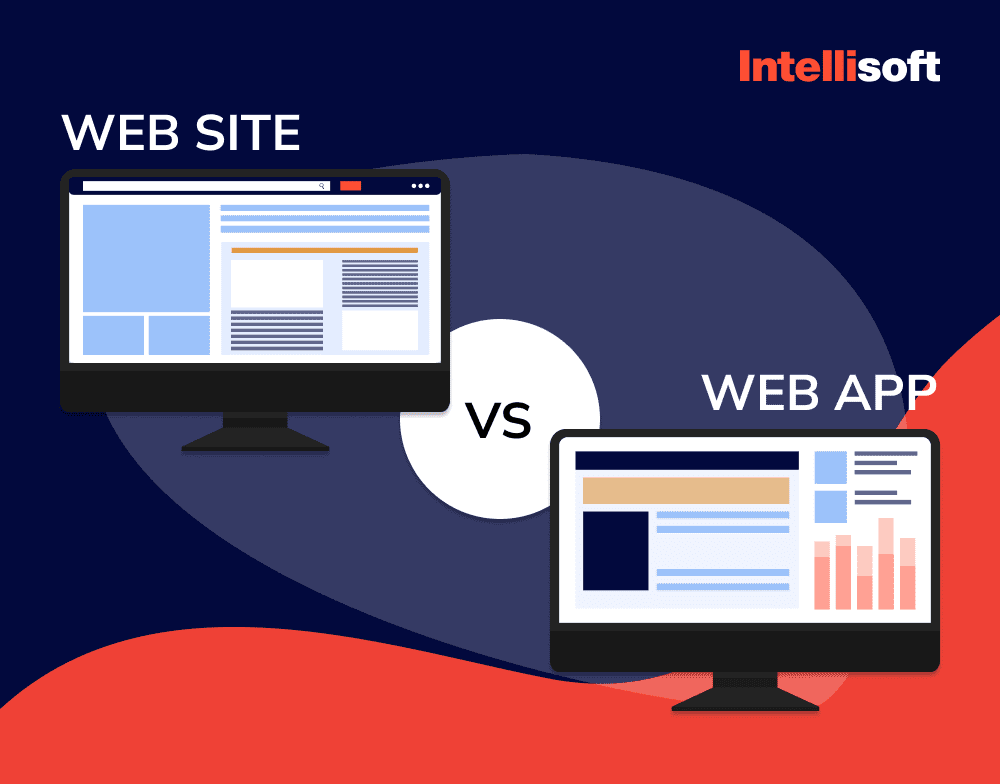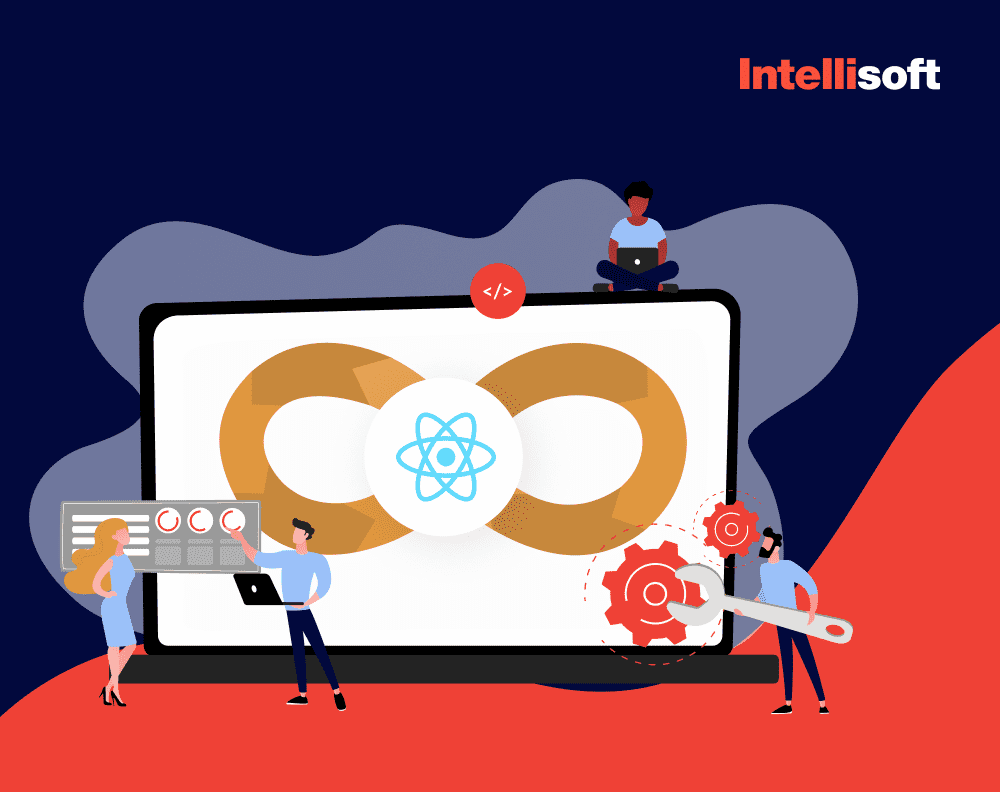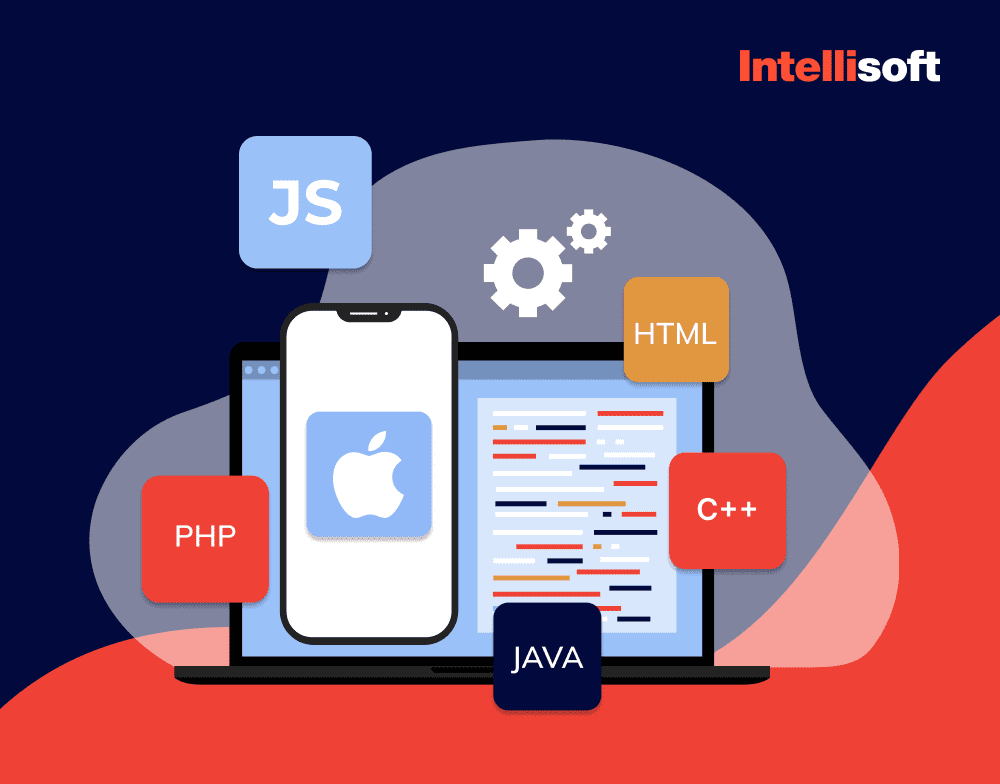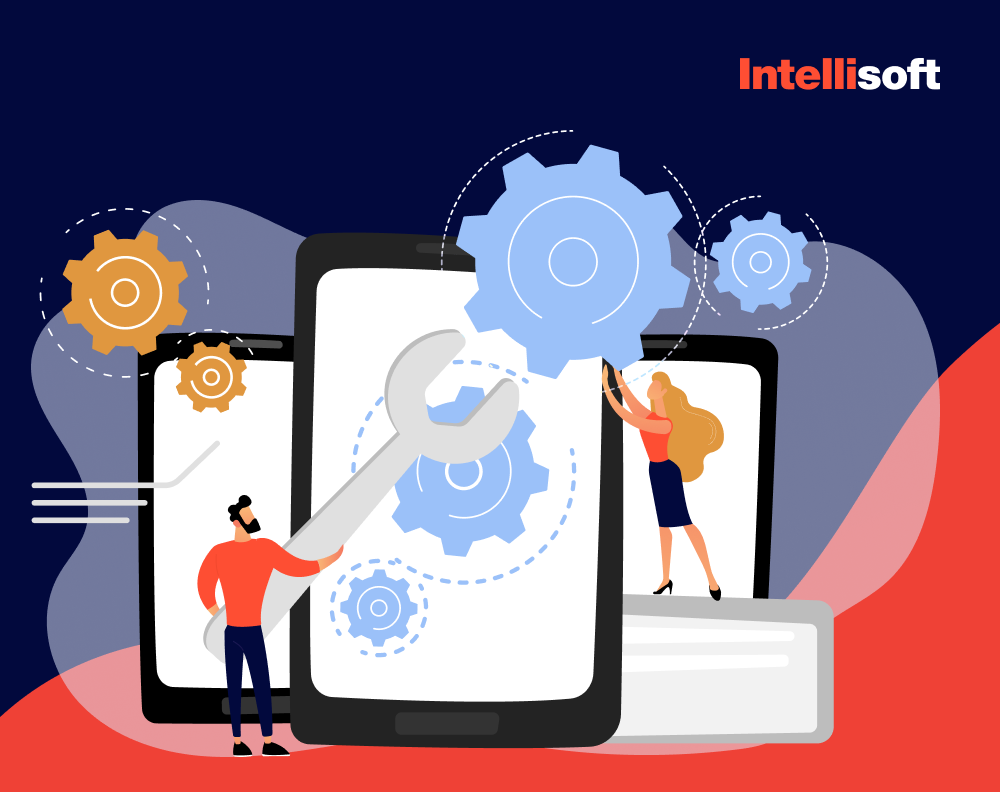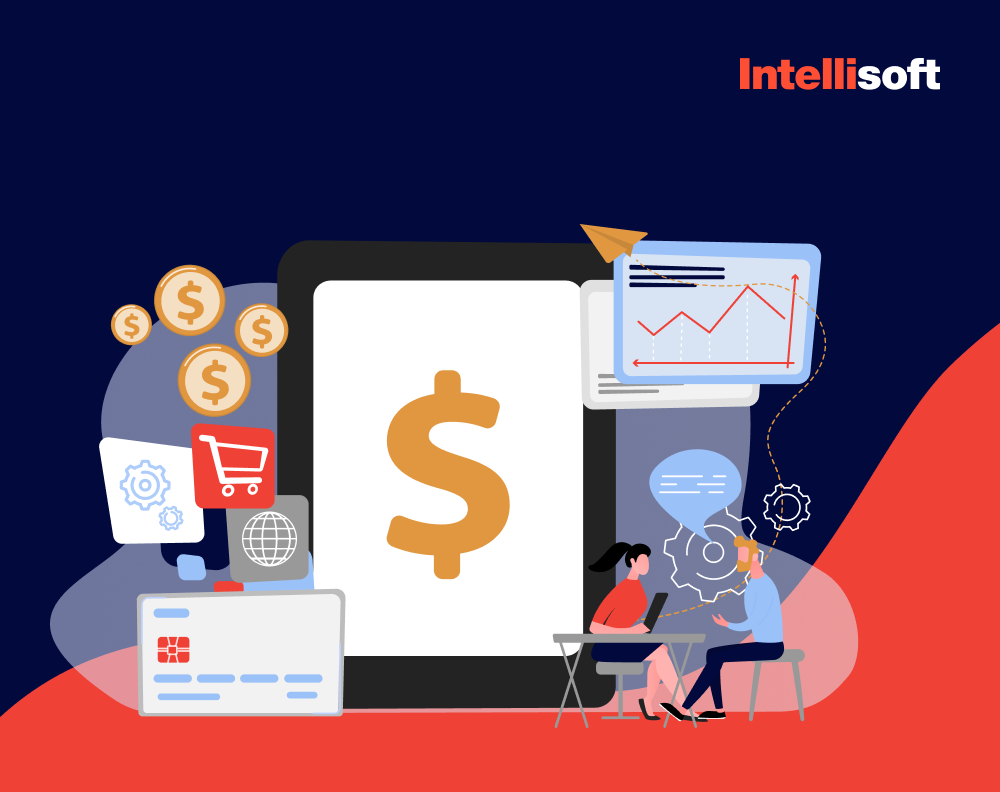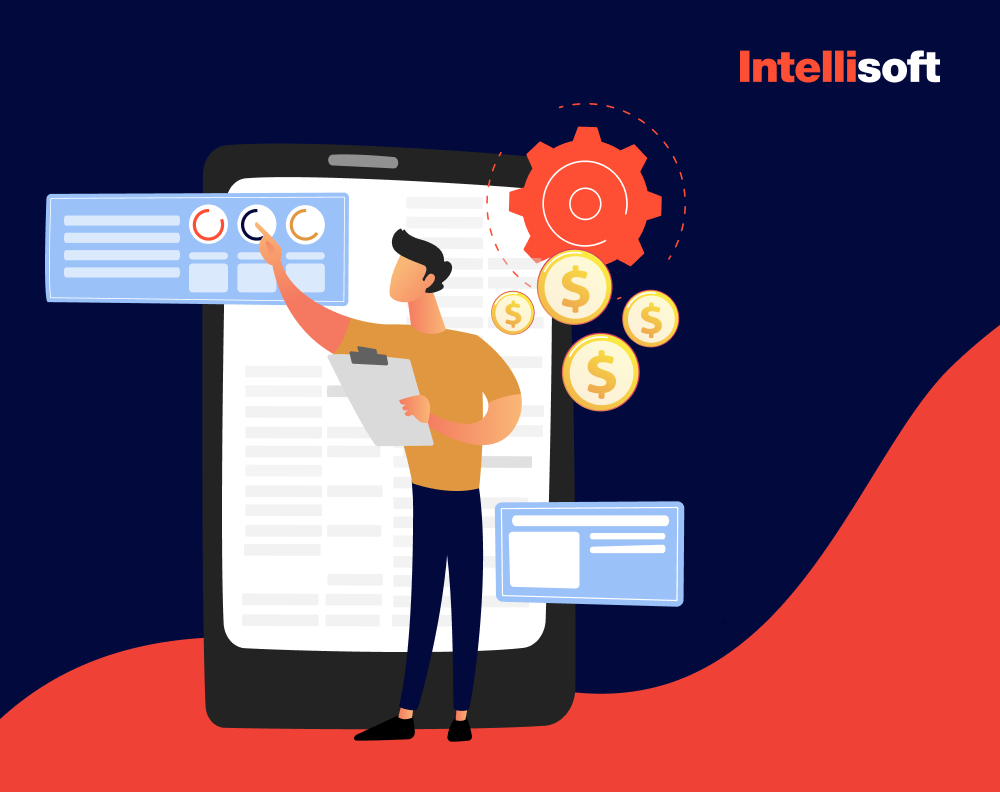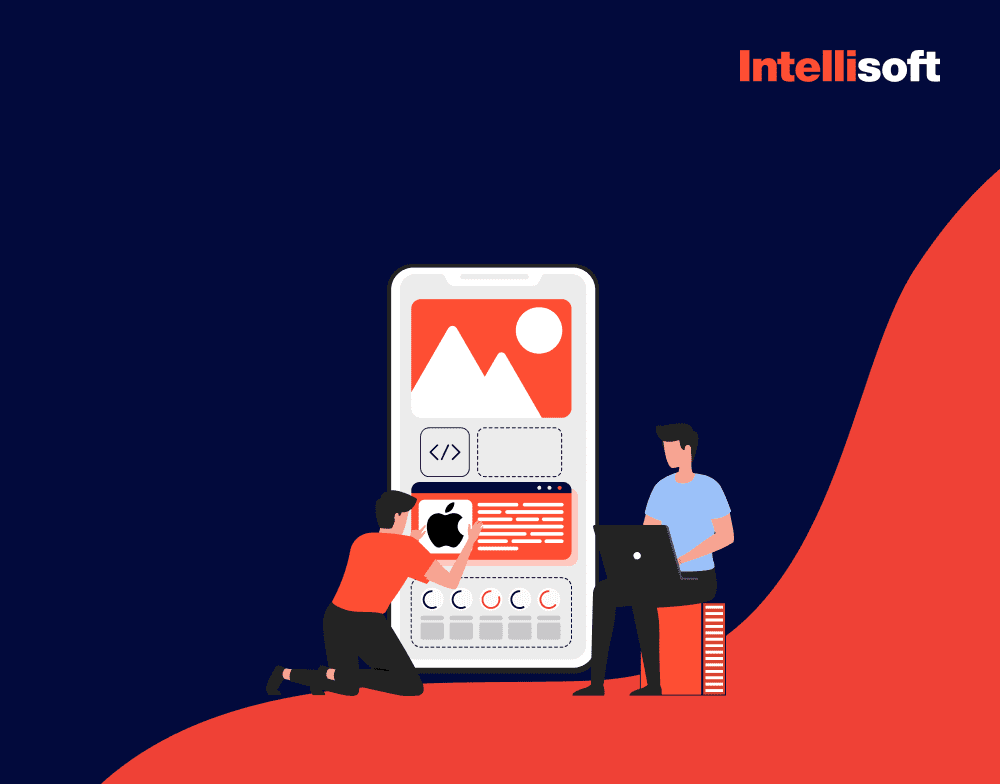Launched by Google in 2008, Android has rapidly ascended to become the world’s most widely used mobile operating system. Today, it powers a vast array of devices from leading manufacturers like Samsung, Sony, Nokia, and Google itself. With over three billion active users, Android captures nearly 70% of the global mobile OS market—an impressive figure that triples the user base of Apple’s iPhone.
This remarkable growth has made Android a prime focus for mobile app development. The platform’s expanding influence attracts numerous software developers, who eagerly immerse themselves in its dynamic ecosystem. And you need to choose an Android coding language for your project.
IntelliSoft, a veteran in the IT industry, exemplifies excellence in mobile app development. With decades of successful projects under our belt, we have earned the trust and loyalty of clients and partners who rely on us to transform their innovative concepts into reality with efficiency and precision. Our ever-expanding portfolio enables us to serve a wide range of industries with tailored mobile solutions.
Intrigued by what lies beyond Java and Kotlin in the realm of Android development? Continue reading to explore the emerging Android app development languages that are shaping the future of mobile apps.
Table of Contents
Types of Android Mobile Apps
After installation on the gadget, the service obtains access to most phone services: camera, microphone, calendar, photo and video files, and other services. After installation, the user can enable push notifications due to access to the device’s notification system.

- Native apps
Native applications are classic mobile tools explicitly developed for specific devices and available for download on Google Play. To create such software, developers use Android app languages, such as Java and Kotlin, which are long and expensive to program.
These tools only support one platform and are accessible through app stores (official and unofficial – for example, the Xiaomi or Huawei stores for Android apps). Native apps can operate without an Internet connection and utilize the phone’s camera, microphone, contacts, and internal memory.
Developers create native applications to run on the target platform – supporting all native technologies and platform-specific hardware features.
- Cross-platform
As the name implies, cross-platform refers to creating applications that can run on different operating systems. Once developers write the application code, they can deploy it to other devices and platforms without worrying about incompatibility issues. This practice is a versatile approach developers widely use to save development time and money. Specialists often use specialized cross-platform frameworks for this purpose.
An example of such development is using the Xamarin framework to create applications that work not only on Windows. Thanks to Mono (an open-source implementation of the .Net platform), projects written in C# successfully run on Unix-like systems.
- Hybrid apps
Hybrid applications have an average speed of operation on the background of the native. However, it is worth choosing hybrid if you need to save significantly on budget and quickly design two ready-made business solutions. Instagram is a vivid example of a successful cross-platform solution whose popularity is beyond words.
Many people refer to hybrid applications as cross-platform, but the only thing they have in common is that they share the same code base. However, the cross-platform approach works well for low-budget applications with secure, stable, and easy-to-maintain features.
Programmers write hybrid tools for two operating systems at once. Such software is multi-functional and workable. Hybrid apps also stand out with the product’s high development speed and visual similarity to the native one.
- PWA apps
Progressive Web App (PWA) is a web development technology that enables an application to exist in a web browser. The page resembles an Android native application in appearance and functionality.
Developers can access the PWA application via a direct link, and users can place its icon on a smartphone, tablet, or any other desktop device. Engineers apply the secure HTTPS protocol to transmit data.
The advantage of PWA apps over native apps is that the system downloads updates instantly when the page reloads. No need to download them additionally. Another advantage is the choice between downloading the app from the store or downloading it from a browser, bypassing the ban on installing apps from unknown sources.
How Long Does It Take to Learn Android App Programming?
Learning Android development language isn’t exactly a walk in the park—it demands a significant time commitment. But just how much time depends largely on where you’re starting from. If you’re completely new to programming, it’ll take longer compared to someone who already has a bit of experience in app development.
Pinpointing the exact amount of time it will take to master programming on Android can be tricky. It really depends on the individual—how dedicated they are, how quickly they pick up new skills, and how much time they can devote to learning app programming languages. Everyone learns langage programmation Android at their own pace, after all.
That being said, we can offer a rough idea based on experience. For someone just starting out, with little to no background in programming, it’s wise to begin with learning Java. Developing a solid understanding of core Java concepts, which are essential for Android development, typically takes around 3 to 4 months. To really become proficient, though, you’re looking at a year to a year and a half of dedicated practice.
In other words, if you’re a complete beginner, it could take you around two years to get comfortable enough to start working on Android app programming projects with confidence.
Android Tech Stack: Which Android Programming Language to Choose
Android developers write not only in Java and Kotlin. But what coding language does Android use? We will analyze nine popular programming languages suitable for developing Android applications.
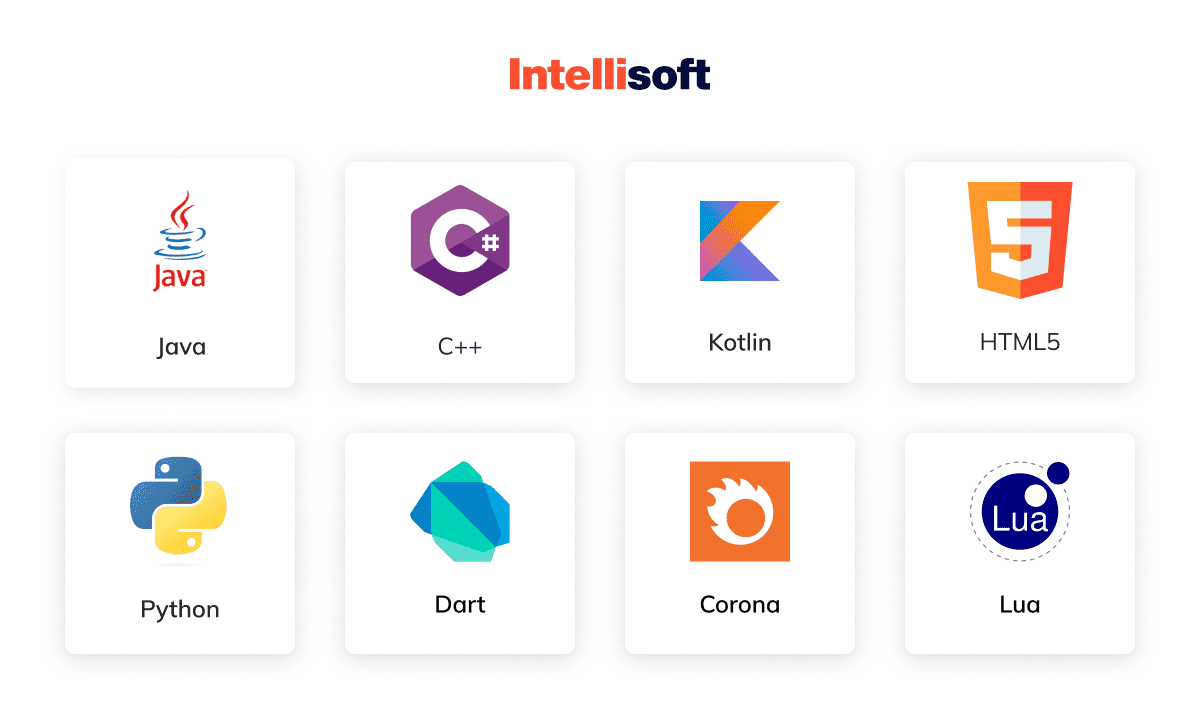
Java
Java is one of the oldest and most proven methods of creating a quality application. It is a popular Android coding language, which appeared in the top 5 best and most functional languages. At the same time, it is pretty complex. It’s hard to figure out because Java works on the type of object-oriented programming. This fact means it works with classes, exceptions, and constructors, which you must carefully consider and think through the logic.
The main advantage of Java is that it has its development environment – Android Studio. In 2014, Google recognized the official Android programming environment, making life easier for developers. The application development process is more straightforward due to the visual UI editor, autocomplete code function, and other features. It allows you to implement the most complex tasks and projects.
C++
Note that you cannot use C++ to create an entire application. Instead, the NDK allows you to create libraries whose functions users can access by parts of the Java code from the application.
As a rule, it is not necessary to use the NDK. Using this environment as a base is not a good idea, if only because you will have to do more coding in C/C++ than in Java. Also, NDK allows the implementation of C and C++ libraries into an application.
Developing Android applications in C/C++ is many times more complex than in Java. More often than not, the performance gain is too insignificant. In other cases, it’s worth sticking with Java wherever possible.
Kotlin
Kotlin is a relatively young Android app coding language that appeared in 2017. However, in such a short period, it managed to win the love of many programmers, and in 2019 Google recognized it as the best programming Android app language, pushing Java to second place.
Kotlin incorporates the best qualities of other languages. It has a lot of advantages, including automatic detection of data types, extension functions, and others. It is easy to understand and master. Kotlin is available to everyone. Kotlin is based on Java, so moving from Java is easy.
Conciseness, easy readability, and conciseness are the main qualities of Kotlin. Its clear syntax improves productivity when creating applications, and consistency is easy to follow. This coding language for Android can easily integrate with many frameworks and learn as its code is open.
HTML, CSS, JavaScript
HTML5, CSS, and JavaScript tools are enough to create a wide variety of applications for both mobile devices and classic PCs. Essentially, the programmer creates a web application that uses all the power and magic of offline platforms.
To create Android apps this way, you can use Adobe Cordova’s capabilities, an open-source framework that supports iOS, Windows 10 Mobile, Blackberry, Firefox, and many other operating systems (OS). However, as helpful as Cordova is, creating a decent app takes some serious work. Many programmers prefer the Ionic Framework project (which uses Cordova to deploy to various platforms).
Python
Yes, enthusiasts have adapted one of the most popular programming languages for Android development. They accomplish this task with Kivy and BeeWare.
Kivy is an open-source library for creating cross-platform applications, including Android and iOS, while BeeWare is a set of UI tools for developing native Android apps. An Android developer who writes mobile apps in Python for Android app development is a rarity. Mostly it’s something for themselves or projects of young, ambitious firms.
Applications in Kivy tend to compile into larger APKs, slow startup, and generally below-average performance. However, each newly released release is genuinely better than the previous one, and today’s mobile devices are so powerful that suboptimal app performance means little. Without native support for Python, you can not take advantage of the native Android environment.
Dart
Dart is a new programming language that is becoming very popular every day. It is a scalable Android coding language for writing simple scripts or full-featured applications. If you create a mobile application, a web application, or a command line script, you can do it with Dart.
Dart implies that programmers will use classes. It is unlike JavaScript, which allows you to use classes or not. With Dart, you have no choice but to include classes. It supports interfaces, mixins, abstract classes, generalized types, and static typing.
Speed, in general, is the main advantage of Dart. Writing and testing Dart code with simple syntax and its work are always faster than the same in JavaScript. In addition, Google’s language is more rigorous and will only let you make some of the mistakes inherent in Javascript.
Corona
Corona is another cross-platform tool that uses the Lua Android app coding language (the scripting language closest in ideology and implementation to JavaScript) to implement application logic. It dramatically simplifies the process of building applications and allows you to apply your libraries.
Lua
Lua is an old scripting language created to supplement programs in more complex languages: C, VB.NET, etc. This Android games coding language has features that distinguish Lua from others like it – for example, starting arrays with one instead of 0 or lacking native classes.
Thus, developers can use Lua as the primary programming coding language for Android apps for specific tasks. The best example of this is the Corona SDK. With Corona, you can create powerful, feature-rich applications deployed to Windows, Mac, Android, iOS, and Apple TV + Android TV. Corona also has built-in monetization capabilities, plus – it is a decent size market where you can find helpful plugins.
Corona is often used to create games (examples include Fun Run 2 and HoPiko). Still, there are also samples of utilities and business applications (My Days and Quebec Tourism).
JavaScript
With the React Native framework, you can create mobile applications with a feature-rich UI. Android development in JS is more viable than in C++, for instance. At the same time, such programs are fully native, as React Native uses the same components as simple Android apps.
In general, JavaScript builds faster than Android Studio. There is Flexbox to create a quality UI. Finally, accessible data transfer over the network using APIs.
Android Toolkit
We will share some of the best tools for improving development productivity and creating better Android apps.
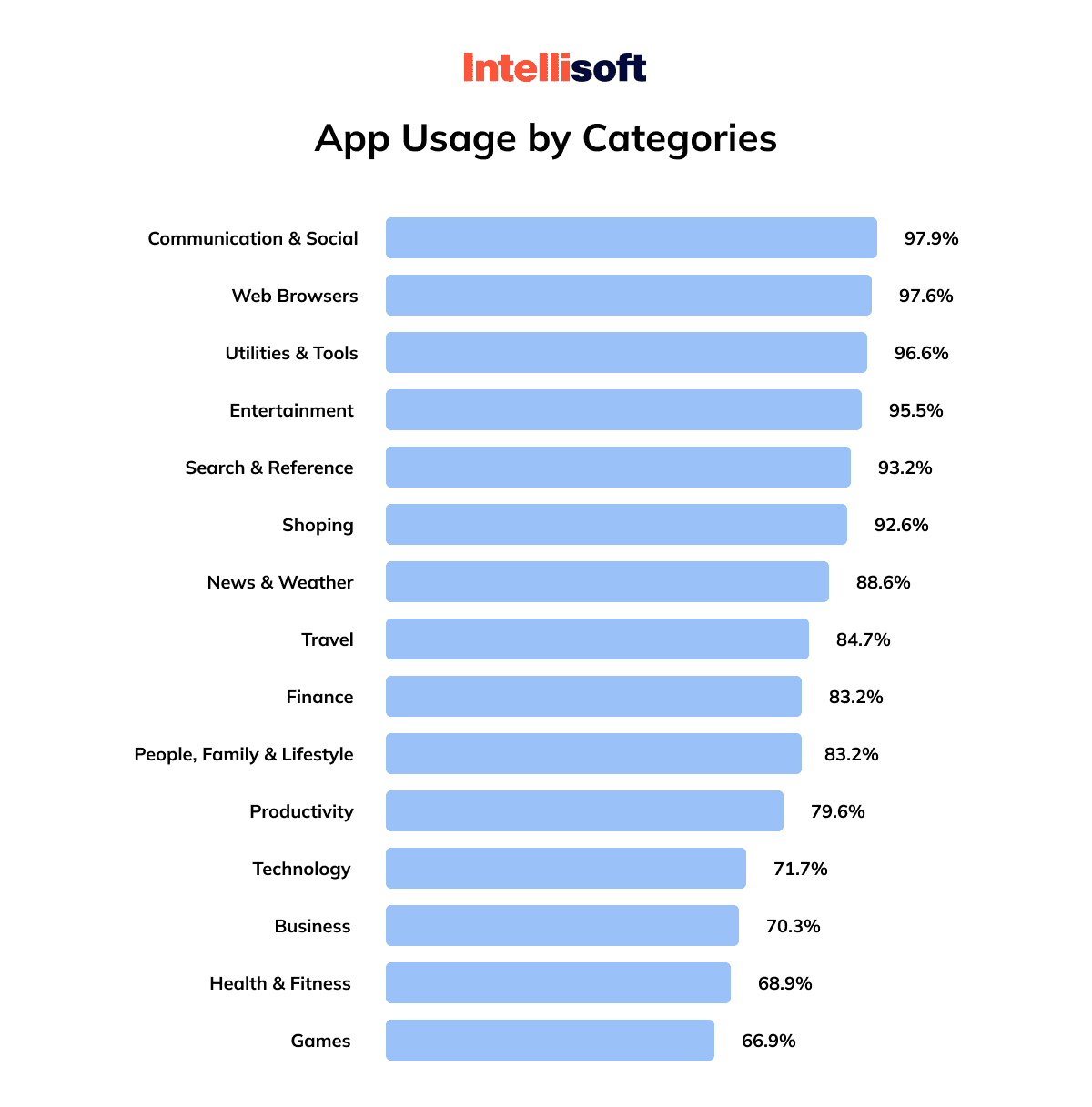
1. Android Developer Tools & Android Studio
Developers can use Android Studio’s fast deployment mechanism, performance tooling, code editing, and debugging. With the Android app development technology stack, you can give your full attention to making apps that are both innovative and useful.
Complete assistance throughout making an Android app is yours to take with the help of the Android Development Tools. In addition, it provides:
- Test automation support that can be scripted.
- A graphical user interface designer.
- Several on-device debugging tools for developers to employ.
2. Android SDK
The software developers must download and install each version of the software development kit (SDK) for a particular phone before designing programs that use the most current capabilities.
Developers have raised the number of apps to millions using this technology stack for Android apps. As a result, the Android app development industry has become the one that businesses choose when they want to communicate with many people.
Related readings:
- Innovation Roadmap: When to Use a Proof of Concept or Prototype
- Assembling Your Dream Design Team: A Comprehensive Guide
- 11 Software Developer Soft Skills Every Programmer Needs to Succeed
- What’s a Proof of Concept? The Complete Beginner’s Guide
- Story Point to Hours: Which Estimation Approach to Choose?
Comparison of Programming Languages for Android App Development
Here’s a comparison table for each popular Android application development language and tools you’ve mentioned, focusing on their primary uses, strengths, and popularity within the development community.
| Language/Tool | Primary Use | Strengths | Popularity in Development Community |
| Java | General programming, Android apps | Robust, versatile, widely used in Android | Very High |
| C++ | System/Software development, game programming | Performance, control over system resources | High |
| Kotlin | Android app development, cross-platform apps | Concise, safe, interoperable with Java | Growing rapidly |
| HTML/CSS | Web development | Fundamental for web, easy to learn | Essential |
| Python | Web, AI, data science, automation, general purpose | Easy to learn, highly versatile | Very High |
| Dart | Web, mobile (Flutter), desktop applications | Optimized for UI, works with Flutter | Moderate |
| Corona | Game and app development | Easy to learn, good for rapid prototyping | Low, but niche in game development |
| Lua | Game development, embedded systems | Lightweight, fast, embeddable | Moderate in specific areas |
| JavaScript | Web development, servers (Node.js), apps | Ubiquitous in web, very flexible | Essential |
| Android Toolkit | Android app development | Comprehensive tools for Android apps | Essential for Android developers |
How to Choose the Best Android App Development Language for Your Project
So many programming languages are out there, so which one should you choose?
Project Classification for the Long Term
Considering the application domain, choosing the appropriate project type is essential to enhance the quality of the product’s user experience and contribute to its commercial success.
Prerequisites for Applications
When deciding on a technology stack for mobile app development, it is essential to identify the app’s primary function. There will be a significant gap in the technology stack you select if you want to build a slow, high-latency mobile app instead of a quick, low-latency one.
Mobile App’s Objectives
When it comes to creating mobile applications, the choice of the technology stack is primarily influenced by the goals the mobile application intends to accomplish.
When you are trying to design a mobile app with high latency, the choice of mobile app technology stack will be very different than when you are looking to develop an Android application with quick response and low latency.
A mobile app based on heavy load processing requires a technology stack far more resilient than apps running around streamlined interactions.
Validation
You need to put your product through some testing if you want to get an idea of how consumers will perceive it in the end. Interacting with your potential users is possible across multiple platforms if you follow this strategy.
Team’s Skills & Experience
When choosing between two similar tech stacks, the best thing to do is look at the developer’s skills. If you add a tech stack, your team isn’t familiar with; it will take more time and effort to build the app and cost more. On the other hand, if your team is friendly with a mobile app development stack, it will help speed up the process without sacrificing quality.
Parent Company of the Technology Industry
It also matters which parent firm created the technological stack you ultimately decide to use.
Brands can vary significantly in the quality of their online resources, with some providing far more information and assistance to their users than others. Facebook’s React Native is rumored to have inferior community support and less sophisticated development possibilities than those of Google, Microsoft, and Adobe.
Safety
Every mobile app development technology addresses security flaws an app may experience once released. The issue arises when you select a mobile tech stack that is poorly documented or necessitates writing numerous lines of code.
The element of developers’ expertise follows after that. If your mobile app is not created securely, hackers will find a way in regardless of the technology stack you are using. Therefore, your app developer staff must be skilled in addition to the tech stack.
Scalability
When approving the stack, you must take its technical requirements into account as well as its growth potential. A tech stack’s role in an application’s scalability is to manage the increasing number of users and load while also making it possible for functionalities to be added.
For instance, you should carefully analyze the tech stack while designing an IoT app because scalability is a crucial factor to consider.
Financial Capacity
Although most tools are ready-made or open-source, product owners must consider several important factors affecting their budgets, such as the developer’s rate, which varies depending on the developer’s area of expertise, licensing fees, and product maintenance costs.
Prefabricated tools allow teams to develop an Android application more quickly. However, the flexibility of some may be limited by installing custom features. Thus, cheap technologies carry their risks.
Time
That could be important depending on your business or the people you’re trying to reach. Various categories of apps are typically time-sensitive.
Unfavorable Consequences of an Incorrect Stack Selection
These problems may arise for your company if you select a technology stack that does not suit your project well:
- Choosing the wrong technology and embracing a different stack will delay your ability to complete the project on schedule. Conceiving and developing the product from scratch will add much more time.
- Scaling horizontally and vertically, you’ll need a tech stack that can handle the load, and picking one without thinking about that will likely lead to failure.
- Challenging to hire sufficiently experienced developers.
- Using questionable technologies in your software may compromise its safety.
How to Find an Android Developer?
Should you hire a freelance engineer or turn to an outsourcing agency for help with your project?
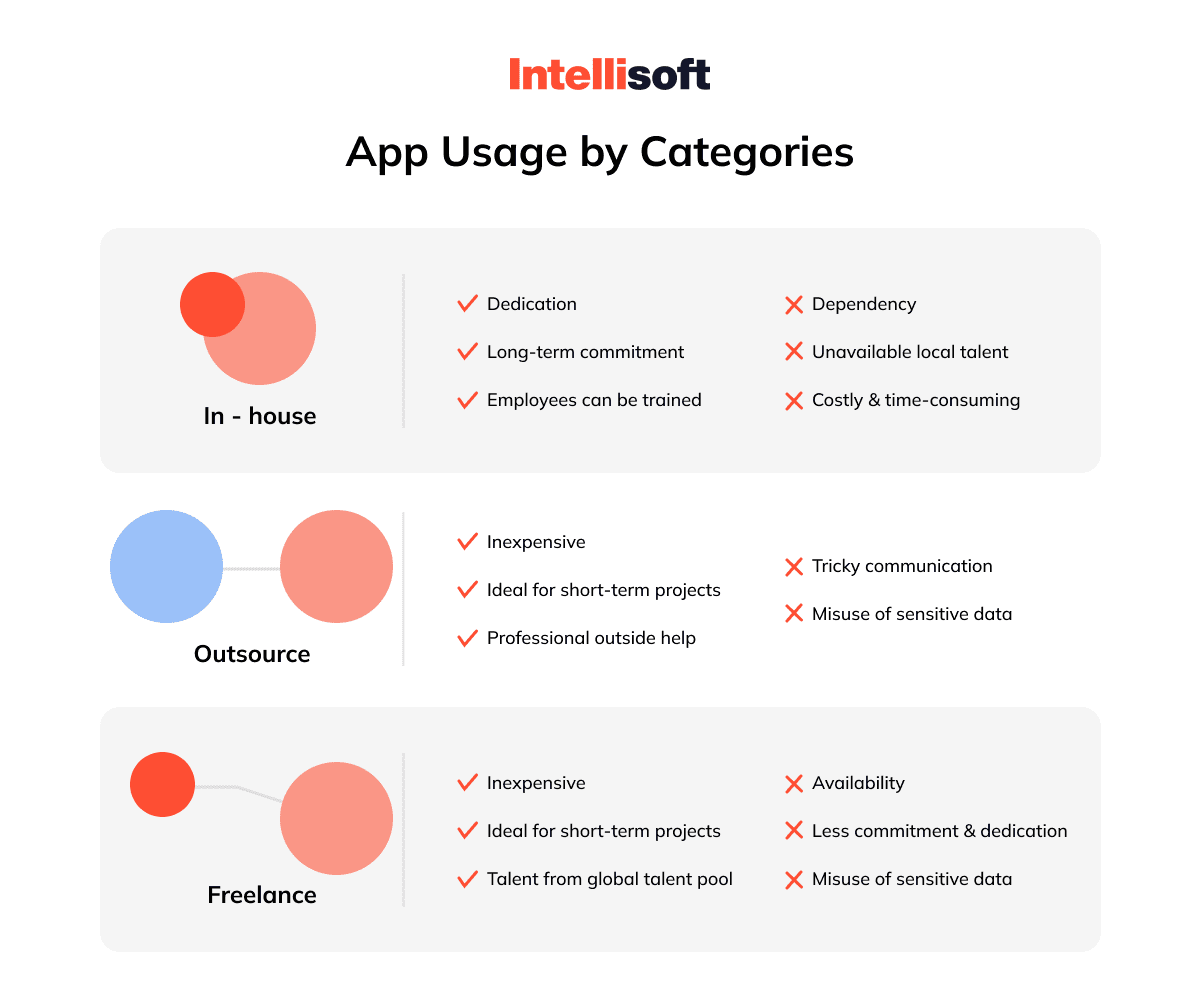
Freelance
Freelancers are free artists from the digital world. They are not members of specific teams but work on a project-by-project basis. You can find programmers, designers, and more on specialized platforms or by word of mouth.
Pros
- Increased working hours. If you are rushed for time, we urge you to select a programmer with a non-stop schedule, as many professionals do not take vacations.
- Less paperwork. Frequently, a freelancer saves you from administrative tasks; you pay them, and everyone is satisfied. Yet, there is a risk of not completing the assignment and losing money.
- The efficiency of work. A remote worker cares only about getting your project done, getting paid, and moving on to the next one ASAP. It makes no sense for them to engage in the kinds of behavior that are common office vices.
- Contact the executor directly. In agencies, managers communicate with clients, whereas a freelancer is willing to answer your inquiries personally.
- Affordability. Freelancers’ primary benefit is their affordability compared to in-house teams and web design agencies. You can make the payment on an hourly, per-project, or per-step basis, depending on what you and the performer agree upon. Also, neither office space nor tax money will be required. Getting started is as simple as locating a suitable coder.
Cons
- Hard to search. Exchanges are full of proposals, but it’s not easy to find a programmer who won’t have to do it over and won’t miss the deadline.
- Lots of threats. If you choose a freelancer, you risk missing deadlines, losing money, and being unable to contact the performer. In this situation, not having a contract can be a cruel joke.
- Micromanagement issues. You must coordinate all the processes when several specialists handle a project. For instance, to avoid having the designer perform extra work if the developer indicates certain aspects are lacking.
- Single-tasking. The search will take longer the more specialists you need. For development, you must look for a programmer and a designer separately.
Inconsistency. A freelancer can quickly abandon a project if another client gives them more money. You’ll have to google “How to find a developer 2 hours before release” quickly.
Outsourcing
Outsourcing is ideal for start-ups. A few groups like it; others despise it. Nothing seems to separate a room full of business experts as quickly as sending a few administrations out of the house.
Outsourcing is when third-party companies mistreat the work usually done in-house and can be a familiar construct to several entrepreneurs. Small firms typically use the payroll process, accounting, distribution, and many alternative vital functions because they don’t need alternatives.
After communicating with a developer, if it becomes clear that they think in the same direction as you and imagine the project in the same way as you do, it is worth starting a mutually beneficial cooperation. To avoid being disappointed in your choice, you should carefully check outstaffing companies.
Pros
- Independence from circumstances. As part of the contract, the outsourcer must provide services on time. The work will be done on time, even if freelancers resign, fall ill, or go on maternity leave or vacation.
- Getting rid of social obligations. The outsourcing company pays for sick leave and vacations and remits deductions to the tax, pension, and medical insurance fund.
- Reduced labor costs. The hiring company does not need to pay for outsourced employee training, buy equipment and software, or spend money on motivation support, bonuses, and benefits.
- Improving the quality of non-core services. The customer can access the intellectual capital of an experienced, highly specialized organization and professionals who know their business.
- Focus on the core business of the company. It reduces resource costs required to manage non-core processes while freeing up additional time and resources for the HR team.
Cons
- Disclosure of confidential information. For example, the company Novaestrat, which provides consulting services to the Ecuadorian market, leaked the data of millions of Ecuadorian citizens. The non-disclosure clauses in the contract and responsibility for violations will help protect against this.
- Falling into dependency. In the absence of competition, the outsourcer can reduce the quality of services, and you will have no one to replace them.
- Unscrupulousness. You need to examine the firm you hire carefully. Unscrupulous companies can withhold wages from their employees and violate the terms of the contract, which will cause problems. Including specific penalties for delays and quality problems in the contract would be prudent.
How to Develop an Android Application
For the purpose of ensuring that your mobile application corresponds to the best possible standards, our team maintains up-to-date with the most recent developments in mobile app development trends and technology. Below, you can see how to build an application using an Android app coding language.
1. Know your target audience
Make sure you are familiar with your target persona. Learn about your target audience’s objectives, behaviors, preferences, and the platforms and mobile devices they utilize. Your app marketing may be helpful in this situation. Make the app appealing to your target market so they will continue to use it.
2. Conduct competitor research
After deciding your goals, it’s time to research your competitors. Choose at least three competitors to research. The organization should choose competitors depending on its objectives and current market conditions. Look for both top firms and innovative startups when selecting rivals. There’s a chance that none of your competitors have an app.
3. Concept proof your app idea
Consider whether your app offers a solution to an existing need before going into the nitty-gritty of development. If it is, consider how it will be beneficial. Or, if your app is organization-specific, evaluate how the digital solution strategy can support your organization’s objectives.
At this point in the development process, pausing to reflect might help you see your app’s future roadmap. Verify that you and your team agree on the app’s most important objectives. You will then know where to begin with a solid foundation.
4. Decide on the core functionality
Most mobile app developers produce a mobile app that’s straightforward, quick to navigate, personalizable, and simple. In addition to this, list additional features that can set your app unique from your competitors. Some must-have attributes are simplicity, quickness, and superb image resolution. All these components are necessary for a satisfying user experience.
Adding a search tool is another remarkable utility feature to keep customers interested. While not as useful for game-based applications, having the ability to search the app is an excellent alternative for e-commerce solutions and social media tools. Another feature to consider adding is cross-platform functionality, meaning compatibility with both operating systems.
Finally, think about letting people opt-in to receive push notifications or linking their accounts to social media. These are additional methods for giving consumers the information they need, tailored specifically to them, which will keep them interested and involved in the long run.
5. Choose a framework/tools & a library
You must first set up your development environment to support your Android development objectives on your desktop. Android Studio and the Android SDK are required for it. You can download both of these as a single file from this page.
The term “integrated development environment” refers to a system where you may enter your code (often written in Java or Kotlin) and gain access to all the various tools required for the development. An IDE is Android Studio. You can access the libraries and APIs from the Android SDK using Android Studio, providing you access to the OS native features. Also, you can test your app using a “virtual device” (emulator), build it into an APK using Gradle, and debug your code live while it is being used.
Here’s how to structure things to develop an Android application more rapidly.
- Choose your app concept.
- Determine your development costs.
- Choose whether you want to create a cross-platform app, an Android app, or an iOS app.
- Configure your security and memory choices.
- Choose the widget and library you want for your app.
- To build your app, select a workable development framework.
The type of Android studio coding language to make an app depends on what it’s for. Java, Kotlin, or Objective-C can make native apps, while React Native or Flutter app development can build cross-platform apps. You could also build a PWA for your business to create much lighter apps that run faster. You should look for the right app for your phone based on whether you want a native, hybrid, or cross-platform app.
6. Decide on an architecture
By properly enforcing excellent software development concepts (KISS, DRY, SOLID), an effective mobile app design can speed up the development process, simplify the development team’s work, and lay a solid foundation for future scalability and growth.
Supporting flexibility and Agile development techniques, improving testing efficiency, and reducing the likelihood of defects in future maintenance are all benefits of having a well-defined mobile app architecture. In the long run, having a well-designed framework for your mobile app will save you money.
A good architecture will work with native and cross-platform choices, making development more straightforward. By analogy, the architecture of a mobile app may be thought of as a skeleton from which the many layers (or “bones”) of the app’s essential components can be constructed.
7. Plan your app design & security
The success of your app mostly depends on its design. The design of the program must incorporate a user-friendly interface. The design’s content and security should be given the utmost importance. Users will be more interested in downloading the app if it is straightforward.
Individuals store valuable information and data that could be considered sensitive on their mobile devices. Make sure you consider the aspects of data protection and privacy settings. It is advantageous to have well-developed security mechanisms built into your software.

8. Create a prototype
Adobe Photoshop is famous as the go-to program for creating high-quality mockups. Finalized mockups of the app’s graphical design are high-fidelity sketches. Use app wireframes to create mockups based on your style guide. The app’s information architecture, user experience, and visual design will likely undergo significant revisions as development continues.
The planned functionalities of an app are commonly described via prototypes. Prototypes or MVPs represent the eventual product’s user interface and app operations. Prototyping can be time-consuming, but it’s well worth it because you can test your app’s design and functionality before committing to them.
9. Release the app
The publication of an app is the last step. The rules your app must follow depend on the app store where you submit your application. The standards for apps uploaded to various app marketplaces vary.
Because your team only needs to create one app, concentrating on a single platform can streamline the app development. While creating cross-platform software ensures strong visibility and the potential for additional users, both popular app stores have limitations.
10. Provide post-maintenance & support
Fixing bugs once the app is ready is not enough. Indeed, there’s always an opportunity for development. Apps have the option to receive updates that add advanced functions and alterations. Your app’s usefulness will quickly dwindle if it doesn’t have any advanced functions.
When an app receives an update that adds new functionality or removes bugs, its popularity soars, and more users download it. You should also know that updating an app to adhere to the standards of several platforms does not render it inoperable.
Conclusion
In today’s competitive landscape, mastering Android coding language is essential for developers. By learning various languages, you can utilize different frameworks to create diverse Android applications.
IntelliSoft is here to help you stay ahead with cutting-edge technology. Whether you run a small business or a large enterprise, we offer comprehensive services tailored to your needs. Our expertise includes web development, mobile application development, IT consulting, and more. Contact us today for an estimate or advice on how we can assist your company!


